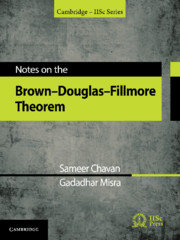Book contents
- Frontmatter
- Dedication
- Contents
- Preface
- From: The Evolution of Modern Analysis, R. G. Douglas
- Overview
- 1 Spectral Theory for Hilbert Space Operators
- 2 Ext(X) as a Semigroup with Identity
- 3 Splitting and the Mayer–Vietoris Sequence
- 4 Determination of Ext(X) as a Group for Planar Sets
- 5 Applications to Operator Theory
- Epilogue
- Appendix A Point Set Topology
- Appendix B Linear Analysis
- Appendix C The Spectral Theorem
- References
- Subject Index
- Index of Symbols
5 - Applications to Operator Theory
Published online by Cambridge University Press: 30 June 2021
- Frontmatter
- Dedication
- Contents
- Preface
- From: The Evolution of Modern Analysis, R. G. Douglas
- Overview
- 1 Spectral Theory for Hilbert Space Operators
- 2 Ext(X) as a Semigroup with Identity
- 3 Splitting and the Mayer–Vietoris Sequence
- 4 Determination of Ext(X) as a Group for Planar Sets
- 5 Applications to Operator Theory
- Epilogue
- Appendix A Point Set Topology
- Appendix B Linear Analysis
- Appendix C The Spectral Theorem
- References
- Subject Index
- Index of Symbols
Summary
In this chapter, we discuss several applications of the BDF theorem. These include a model theorem for a family of essentially normal operators, classification of essentially homogeneous operators, description of essential spectra of essentially normal circular operators. We also discuss applications to the theories of hyponormal and m-isometric operators. We conclude this chapter with a fairly long discussion on essentially reductive quotient sub-modules.
Bergman Operators and Surjectivity of
Let G be a bounded open subset of the complex plane C and let dA denote the normalized area measure on G. Let (or stand for the Hilbert space of dA-square integrable Lebesgue measurable functions on G (with two functions being identified if they are dA-almost everywhere equal to each other). Let
The normed linear space, with the norm inherited from, is a reproducing kernel Hilbert space as shown here.
Lemma 5.1.1
For any compact subset K of G; there exists such that
In particular, for every, the point evaluation is bounded on and is a Hilbert space.
Proof Let and let. By the mean value property for analytic functions,
It follows now from the Cauchy–Schwarz inequality that
As r can be taken to be arbitrarily close to dist; we get
Let and note that by applying the estimate above, we obtain
A routine compactness argument now yields (5.1.1). To see that is complete, it suffices to check that is closed in. By (5.1.1), the convergence in yields the uniform convergence on all compact subsets of G. As uniform limit of analytic functions is analytic, the desired conclusion may be derived from the fact that every convergent sequence in has a subsequence converging pointwise almost everywhere.
By Lemma 5.1.1 and the Riesz representation theorem (see Lemma B.1.8), for any w ∈ G, there exists such that
The two-variable function, is uniquely determined by the reproducing property (5.1.2).
We now define the Bergman operator BG as the operator of multiplication by z on. As G is a bounded subset of, defines a bounded linear operator on. Moreover, for every is an eigenvalue of. Indeed, for any,
that is,. This also shows that, and more importantly, the spectrum of BG has nonempty interior.
Let us compute the essential spectra and index data of Bergman operators.
- Type
- Chapter
- Information
- Notes on the Brown-Douglas-Fillmore Theorem , pp. 147 - 178Publisher: Cambridge University PressPrint publication year: 2021



